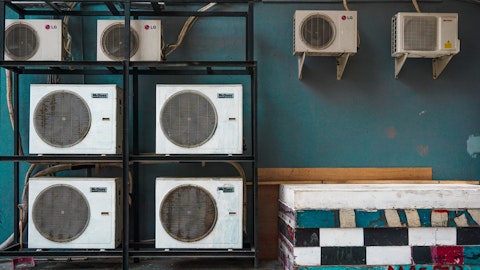Ryan Merkel: Okay. Fair enough. Thank you.
Operator: The next question comes from David Manthey with Baird. Please go ahead.
Albert Nahmad: Good morning David?
Operator: Mr. Manthey, your line is open. Please go ahead with your question. Is it muted accidentally?
Dave Manthey: Got it. Yeah, hey. Good morning Al, good morning everyone. Can you hear me now?
Operator: Yes. Please go ahead, sir.
Dave Manthey: So I’m going to stay on the gross margin topic, if I can here. Were there adjustments in the fourth quarter that hit gross margin disproportionately hard. Barry, you’re kind of saying the year-over-year comparison looking back and then looking forward, are you implying that the gross margin a year from now, give or take, will be in the range that it was this year? Or was there something unusual in this fourth quarter that might affect that comparison?
Barry Logan: Yes, good question. Well, a year from now, again, we’ll have a completely different blend of new products a year from now. I would expect that to be a margin opportunity a year from now. There are no adjustments or funk that had hit this quarter that I would call out as being material or even important to talk about or even immaterial to talk about, really nothing that stands out. So yes, I think going back to the algebra of price and inflation and the seasonality and so on, again, I would expect as we get into season, we have pricing actions in our pocket. We have new products being introduced. And I would say, a continuance of the technology that we’ve been using to improve margin. And as far as a year from now and next fourth quarter, again, I think there’s an opportunity to improve margin, but nothing that penalized this quarter in a particular way that would be important.
Dave Manthey: Okay. And yes, I appreciate you indulging us on all this quarterly conversation, which I don’t think historically we would have done here. But Barry, you also said we need to get through the first quarter and you were kind of talking again about that year-to-year comparison, if you were down a couple of hundred basis points in the fourth quarter year-to-year because of all the items you mentioned, and then we look to the first quarter, that would put us in a range in the what, the 26.5%, 27% range. Just trying to understand the cadence, again, knowing there’s a lot of moving parts there. Is there anything in the first quarter unusual that we should think about their relative to your comments, Barry?
Barry Logan: Yeah, I think the pricing actions of the OEMs are pushed out a little bit into the late first quarter, early second quarter, if I look at things comparatively to last year. So you can read into that comment and in terms of modeling, you can consider the comment. So sequentially, I think, again, there’re going to be certainly better margin in the first quarter versus a year ago, you have to consider my comment about the timing of some of the pricing actions that we’re describing.
Paul Johnston: That’s a good point, Barry, because instead of a January 1 price increase, most everybody went February 1, March 1. So it’s a little bit of a lag to Barry’s point.
Barry Logan: A top 10 vendor that went April 1 instead of January 1. So some of this — the benefit will push a little bit later into 2024 than simply January 1.
Dave Manthey: Great. Thanks very much guys.
Operator: The next question comes from Brett Linzey with Mizuho. Please go ahead.
Brett Linzey: [Multiple Speakers] Just want to come back to the inventory. So you took another $208 million out of the system. I believe that was a little bit ahead of your initial plan. But maybe you could just speak to your assessment of inventory levels as we begin to move into the selling season? Are there more actions that need to be taken, largely complete? How are you thinking about that?
Albert Nahmad: Well, I’ll give you a big picture of it is that we do want and we’ll work on higher inventory turns. So I do expect to have our inventory produce more cash flow as it turns. And the science that we use is to do that, is being implemented. It’s a very long process, longer than I expected. But eventually, what you’ll see is lower investment in inventory and higher returns when compared to sales.
Paul Johnston: Yes, absolutely. This is Paul. Historically, it’s been a four plus turn industry. And obviously, during the pandemic and the supply team is disruption, everybody got lost in the mid- to low 3s. And so now as we strive to get back to the four turns, obviously, we’re going to have a reduction in inventory. Right now, we’re seeing better cooperation and better lead times coming out of our OEMs pretty much across the board. And as those lead times improve, obviously, that gives us a better position to not have to stock as much inventory. So that’s one thing that’s happening. Secondly, Watsco has got an unusual position on inventory in each one of our operating units manages inventory. So there’s not one big central headquarter directive that gets into the inventory.
We manage it in much smaller blocks with each one of the operating units actually functioning against their vendors, what they need to have in stock and inventory. Plus Watsco invested during — before the pandemic. We invested heavily in the technology it takes to manage inventory, putting in new inventory management systems. It gives us daily management reviews so that we can identify what we have on hand, what we have on order, by region, by district, by branch. So a lot more visibility than you’d find in a normal distribution company.
Brett Linzey: Yes, that’s great. And then just shifting to the non-equipment versus equipment trends as well as in the second half being a little better than first half. I guess it doesn’t suggest there’s a meaningful retrenchment in the consumer on the replacement side. Is there anything in terms of high efficiency mix or credit metrics or things that you’re watching internally that would suggest there’s a step down here in 2024 early in the year?
Paul Johnston: Take a stab on the equipment side. The — as we indicated a year ago, and we went to the higher efficiency minimums that were regulated by the government, we expected there to be a compression around the entry-level product. And we went from around 65% of the minimum efficiency products up to around 85%. So we’ve definitely seen more product coming out. It’s higher-efficient product than what we had before, but it has distorted the industry a little bit towards the minimum efficiency as opposed to high efficiency.
Barry Logan: And it’s a good question on credit. It’s not asked often enough, frankly. So we — obviously, our accounts receivable represents contractor credit giving the average contractor about $10,000 a month and a credit line essentially. And so if you look at our cash flow statement, which is published in the press release, you’ll see bad debt is actually down about 20% this year. So there’s no obvious indication of change in the quality of the portfolio. It’s roughly 10, 11 basis points of bad debt and again, compare that against any peer or any kind of other distribution model you can find, it’s in a very favorable position. So credit is not something we’re seeing a risk. It’s how we serve customers and again, so far, so good from an economic point of view.
Brett Linzey: All right. Appreciate the color. I will pass along.
Operator: Next question comes from Jeffrey Sprague with Vertical Research. Please go ahead.
Albert Nahmad: Good morning, Jeffrey.
Jeffrey Sprague: Good morning, Al. Good morning everyone. Thanks for the time. Hey just kind of back on price. Just wonder what, if anything, you make of the OEMs kind of going later and kind of not at the same time. Is there sort of a message here of kind of price fatigue in the market do you think? Is there a game theory or something we should be thinking about?
Paul Johnston: I don’t think it’s that diabolical. I think it’s just a natural progression of how they intend to roll out their new product introduction on the A2L and if you listen to each one of the OEMs on their public broadcast, you find that they each are putting out a different variety of products at different times during the year. And I think it has more to do with their engineering and their manufacturing plants and all that, that goes into rolling out the product.
Jeffrey Sprague: Yes, interesting. Makes sense. And then just kind of back to the replacement question I was asked kind of at least obliquely a couple of different ways. Al, in your opening, you kind of talked about the inevitability of after a year like 2023 here. If we do go back to just that kind of old school demographic replacement [indiscernible] into the whole 15-year life and all that argument. We’re echoing against 2009 right now, right? So that math could argue for another soft replacement year. I just wonder your thoughts on that and kind of what you’re seeing in repair versus replace?
Albert Nahmad: Well, our guru and that is Paul Johnson.
Paul Johnston: Oh my God. Start with the repair versus replace. It’s is fourth quarter, first quarter, which is not the time when you’re going to see a lot of repair going on out there. You don’t have your air conditioners working, you have your heat pumps and your gas furnaces, which your gas furnaces are generally a lower repair item. So to date, we’re not declaring that there’s any trends that we’ve been able to identify and repair versus replace. Will it occur when the temperature goes up, we’ll wait and see and find out. The other part of your question was what?
Jeffrey Sprague: Just the underlying health of replacement demand based on kind of where the installed base is and sort of the age of the installed base.
Paul Johnston: The age of the installed base is newer than it’s probably ever been since I’ve been around, which is a long time. But obviously, the mix of the installed base is changing. Gas furnaces generally have a lifetime. You can make a gas furnace last 25, 30 years, whereas a straight cool unit, I think the industry has said, it’s around 15, 16 years. Heat pumps are something that are growing as a percentage of the total business. And those generally don’t have as long a lifetime. Remember, they’re not just operating in the wintertime, they’re operating in the summertime also. So you’ve got more hours being packed on to that piece of equipment. What that’s going to do to the overall mix of installed base out there right now.
I think that’s going to be one of the questions that we’ll be able to look at probably in the next year or so. But replacement pull up, I figured that we probably had 2.5 million to 3 million units were pulled up troughing the pandemic. They were installed perhaps prematurely, perhaps not. Trying to get some data around that to see what the geography was of those replacements? Was it North or was it south? Where people were actually replacing equipment. A lot of data coming in, a lot of data that needs to be analyzed to answer that question properly.
A.J. Nahmad: Paul, I think you said something [indiscernible] This is A.J. In your 40 years in this industry, this is probably a dynamic period for the space as there’s ever been between — I mean all these questions are pointing to all the different in outs and change in paradigm between the supply chain, changing again the OEMs going with different pricing, different times, the change of rates of pricing going up and inflation, the inventory and the change to the A2L products coming out. There’s so many different things going on in the industry today, which creates a lot of noise. But I have to say that I think Watsco is very well positioned. Our inventory has come down. The quality of our inventory has gone up as far as lower excess and slow and damaged inventory.



